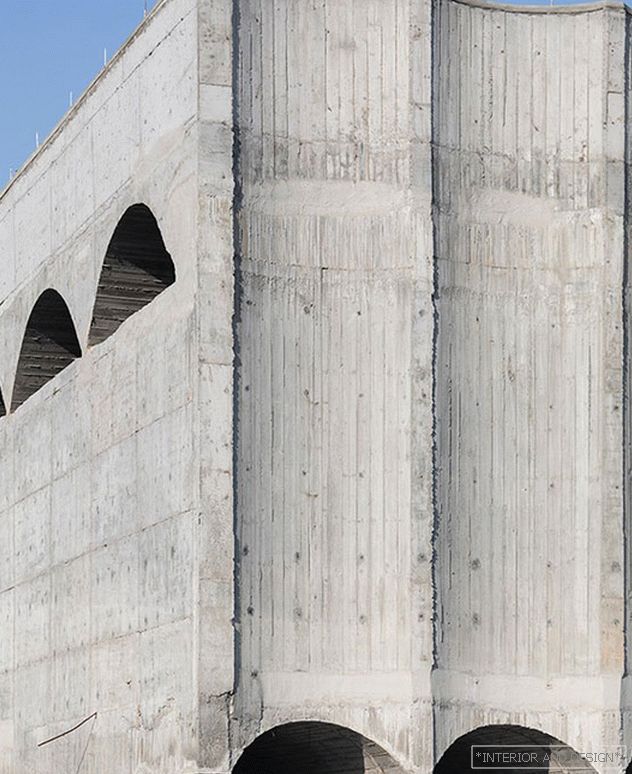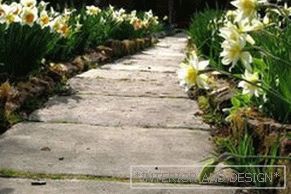 A private house is a complete composition in the event that it is not just a house and its territory, but a combination of original ideas of the designer and modern technologies. Such a union will help turn the garden area with the house into a well-kept and cozy natural corner. Garden paths are the main design element, which, in addition to the aesthetic component, also carries a functional load.
A private house is a complete composition in the event that it is not just a house and its territory, but a combination of original ideas of the designer and modern technologies. Such a union will help turn the garden area with the house into a well-kept and cozy natural corner. Garden paths are the main design element, which, in addition to the aesthetic component, also carries a functional load.
The comfort of the owners of the site will depend on the correctness of the original layout of the tracks.
Garden paths should be enough durable and should be the decoration of the site. For an experienced designer, it is not a secret that short paths divide the whole area into small fragments, thereby visually reducing the size of the garden. At the same time, long paths create a feeling of a spacious plot.
At the initial planning stage, the homeowner needs to decide on the functional purpose of the tracks and their size. For example, the path leading to the front of a house must be at least 2 meters wide so that two people can freely disperse on it. For technological purposes, it will be enough to see 90 cm. The tracks on which the car will move must be no less than the width of the car itself, made of durable materials and have a rough surfaceto prevent slipping in winter.
The modern market of building materials is ready to offer buyers for a paving of paths on a site a rather large list of materials. It can be tile, natural or decorative stone, crushed stone.
Content
- 1 Advantages and disadvantages of concrete tracks
- 2 Technology create concrete tracks
- 2.1 Mounting the formwork
- 2.2 Forming a pillow
- 2.3 Reinforcement and Fill
Advantages and disadvantages of concrete tracks
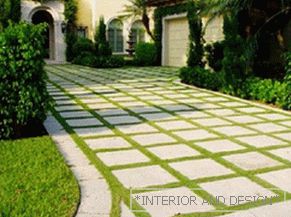 Sand-concrete mix is one of the most popular materials for creating tracks. TO benefits This material and garden paths from it include the following:
Sand-concrete mix is one of the most popular materials for creating tracks. TO benefits This material and garden paths from it include the following:
- good strength properties of the material, its durability;
- ease of creating concrete structures, including garden paths;
- low cost of material;
- resistance to adverse weather factors (moisture and frost resistance);
- resistance to mechanical stress;
- возможность изготовить дорожку любой конфигурации (главное, сделать подходящую formwork);
- possibility of installation by myself, without the involvement of specialists;
- широкие возможности для декорирования дорожек (во время приготовления solution можно добавить пигменты любого цвета, либо использовать плиточную мозаику, природный или искусственный камень
etc. ; here the main thing is to put design elements and decorations into the solution several hours after pouring).
TO disadvantages садовых дорожек из concreteа можно отнести следующие факторы:
- when the ground moves during the off-season, the concrete path can go cracked;
- a concrete path is a capital structure; it will be hardly possible to change its direction later. Therefore, when planning the location of the tracks, it is necessary to simultaneously plan the territory around them;
- it will take a lot of time and effort on preparatory work and installation.
Технология создания concreteных дорожек
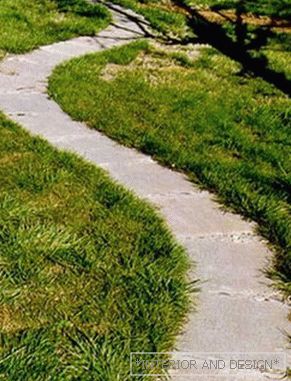 Actually, the whole process of self montage садовых дорожек из concreteа достаточно прост и состоит из следующих этапов:
Actually, the whole process of self montage садовых дорожек из concreteа достаточно прост и состоит из следующих этапов:
- marking the surface of the soil under the garden paths;
- preliminary soil preparation;
- installation of formwork;
- pillow formation;
- установка reinforcing элементов и заливка concreteа.
In order for the concrete garden path to please its owners for many years, it is necessary to carefully consider each stage separately.
- Markup The soil surface under the garden paths is the quickest and easiest stage. The owners need to decide on the location of the tracks on their site and on their size (as previously mentioned, they will depend on the expected functional loads). The markings are made with the help of ordinary pegs, which are driven into the ground at regular intervals from each other, and the rope is tensioned between them. At this stage can be considered complete and proceed to the next.
- Preliminary training ground. The essence of this stage is to select the top layer of sod to a depth of ≈ 5 - 7 cm. This is necessary in order to remove the roots of all plants along the path of the paving path. If this is not done, then the plants under the path will gradually rot, and water will enter the resulting voids and freeze there during the winter periods. The freezing water will increase in volume and put pressure on the lying track. Ultimately, this process may lead to cracking of the concrete pavement.
In addition, it will be convenient for people and for use in the summer lawn mowers, if the garden path will be on one level with a primer.
Mounting the formwork
Formwork it is mounted from boards and it is needed for pouring concrete. In order to create any smooth bends of the walkway, it is quite possible to use plywood or any other bending materials for the manufacture of the formwork. The formwork can be made at once along the entire length of the path, but since it is necessary to fill the solution with parts (it is necessary, because it is necessary to provide seams to compensate for expansion-contraction of concrete under the influence of temperature), then the formwork can also be made into parts, which will reduce the material consumption for its manufacture .
Pillow formation
Pillow under the concrete path has two objectives.
- Uniform distribution of the weight load of the concrete path.
- Drainage.
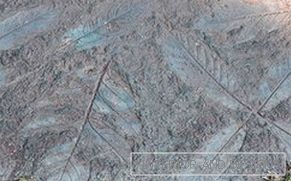 A pillow or base under the path is made of a layer of compacted rubble and a layer of sand. The sand does not retain water, and in winter the soil under the path will not freeze and expand. However, sand is a fine-grained material, for which it is common to eventually go to rubble or soil. If a sand will be laid directly on the rubble, then after a few years it will go into the ground with water. To prevent this process, any materials are laid directly on the ground. waterproofing. Это может быть рубероид, геотекстиль или агроволокно. Последние два материала наиболее предпочтительны, так как они не подвержены гниению и прекрасно пропускают воду. После того как щебень уложен и sand засыпан, его нужно good tamp. Если sand сухой, надо его намочить, тогда он плотнее утрамбуется и в нем не будет пустот. TOроме того, песчаную подушку надо разровнять, чтобы впоследствии толщина слоя concreteа была равномерной.
A pillow or base under the path is made of a layer of compacted rubble and a layer of sand. The sand does not retain water, and in winter the soil under the path will not freeze and expand. However, sand is a fine-grained material, for which it is common to eventually go to rubble or soil. If a sand will be laid directly on the rubble, then after a few years it will go into the ground with water. To prevent this process, any materials are laid directly on the ground. waterproofing. Это может быть рубероид, геотекстиль или агроволокно. Последние два материала наиболее предпочтительны, так как они не подвержены гниению и прекрасно пропускают воду. После того как щебень уложен и sand засыпан, его нужно good tamp. Если sand сухой, надо его намочить, тогда он плотнее утрамбуется и в нем не будет пустот. TOроме того, песчаную подушку надо разровнять, чтобы впоследствии толщина слоя concreteа была равномерной.
For the manufacture of pillows instead of sand, you can make a thin concrete screed or use flat stones, but you need to deepen the trench under the walkway to the thickness of the stone or screed.
Reinforcement and fill
The next step is styling. reinforcing элементов и заливка concreteа. Перед тем как укладывать армирующую сетку или арматуру, на подушку из песка надо положить полиэтиленовую или любую другую пленку. Это необходимо сделать по следующей причине: concrete должен не высохнуть, а затвердеть. Затвердевание — это химическая реакция при непосредственном участии так называемого цементного молочка, придающего concreteу прекрасные прочностные характеристики. Чтобы этот компонент не ушел в sand и нужна пленка. Далее можно укладывать армирующие элементы: стандартную арматуру, армирующую сетку, сетку для стяжки или любые другие материалы.
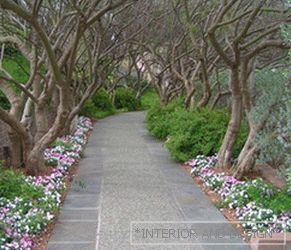 Now you can start mixing solution. It can be made from sand and cement (1: 3), you can buy ready-made dry mixes that are diluted with water. If the walkway will only walk, then the thickness of the cushion and the layer of concrete should not be less than 5 cm. If the coating experiences heavier loads, then the additional and concrete layers should not be less than 7.5 cm.
Now you can start mixing solution. It can be made from sand and cement (1: 3), you can buy ready-made dry mixes that are diluted with water. If the walkway will only walk, then the thickness of the cushion and the layer of concrete should not be less than 5 cm. If the coating experiences heavier loads, then the additional and concrete layers should not be less than 7.5 cm.
По мере заливки solution его надо to level. After all the ready portion of the solution is poured, it must be further smoothed by the rule and compact as much as possible until the cement jelly appears. When the solution is slightly grabbed, you can trim it with a spatula. At the same time, it is possible to put decorating elements into the solution (if this was previously supposed to be done). In order for the concrete to harden, not dry, the track can either be covered with a film, or periodically moisten the surface of the track with water. After a couple of days, you can clean up formwork, and after a few more days the “pedestrians” can use the path.
Having made a decision on the manufacture of paths on a garden plot of concrete, you can independently and with minimal financial costs give your land tenure a complete image and elegant appearance.



